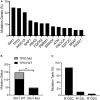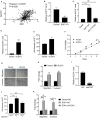Mutation of Isocitrate Dehydrogenase 1 in Cholangiocarcinoma Impairs Tumor Progression by Inhibiting Isocitrate Metabolism
- PMID: 32373065
- PMCID: PMC7187788
- DOI: 10.3389/fendo.2020.00189
Mutation of Isocitrate Dehydrogenase 1 in Cholangiocarcinoma Impairs Tumor Progression by Inhibiting Isocitrate Metabolism
Abstract
Aim: Isocitrate dehydrogenase 1 (IDH1) is key enzyme involved in cellular metabolism and DNA repair. Mutations in IDH1 occur in up to 25% of cholangiocarcinomas. The present study aimed to explore the features of cellosaurus REB cells with mutant and wide-type IDH1. Methods: To compare the features of IDH1 knockout and mutation in cholangiocarcinoma, we firstly constructed the IDH1 knockout and IDH1 mutation cell lines. We then evaluated the viability of these cell lines using the cell count assay and MTT assay. Next, we determined cell migration and invasion using the Transwell assay. Additionally, to evaluate the effects of IDH1 on cellular metabolism, the levels of α-ketoglutarate (α-KG) and nicotinamide adenine dinucleotide phosphate (NADPH) were determined using enzyme-linked immunosorbent assay. We then applied ChIPbase dataset to explore the genes that were regulated by IDH1. Results: High frequency of mutated IDH1 was observed in the cholangiocarcinoma and IDH1 R132C was presented in more than 80% of mutations. The results showed that IDH1 knockout decreased cell proliferation, migration and invasion, whereas the overexpression of IDH1 in IDH1 knockout cell line recovered its proliferation, migration and invasion capacities. Additionally, IDH1 mutation reduced the levels of NADPH and α-KG. Furthermore, investigation into the underlying mechanisms revealed that IDH1 overexpression induced the expression of aldehyde dehydrogenase 1 thereby promoting cell proliferation, migration and invasion. Conclusion:IDH1 plays an important role in cholangiocarcinoma and its mutation impairs tumor progression in part by inhibition of isocitrate metabolism.
Keywords: NADPH; aldehyde dehydrogenase 1; cholangiocarcinoma; isocitrate dehydrogenase 1; α-ketoglutarate.
Copyright © 2020 Su, Zhang, Zheng, Wang, Zhu and Li.
Figures





Similar articles
-
IDH1 Targeting as a New Potential Option for Intrahepatic Cholangiocarcinoma Treatment-Current State and Future Perspectives.Molecules. 2020 Aug 18;25(16):3754. doi: 10.3390/molecules25163754. Molecules. 2020. PMID: 32824685 Free PMC article. Review.
-
ALYREF Promotes Progression of Intrahepatic Cholangiocarcinoma through Increasing the Level of Isocitrate Dehydrogenase 1 in an m5C-Dependent Manner.Mol Cell Biol. 2025;45(5):198-211. doi: 10.1080/10985549.2025.2490031. Epub 2025 May 14. Mol Cell Biol. 2025. PMID: 40369958
-
Mutations in isocitrate dehydrogenase 1 and 2 occur frequently in intrahepatic cholangiocarcinomas and share hypermethylation targets with glioblastomas.Oncogene. 2013 Jun 20;32(25):3091-100. doi: 10.1038/onc.2012.315. Epub 2012 Jul 23. Oncogene. 2013. PMID: 22824796 Free PMC article.
-
Mutations of isocitrate dehydrogenase 1 and 2 in intrahepatic cholangiocarcinoma.Curr Opin Gastroenterol. 2014 May;30(3):295-302. doi: 10.1097/MOG.0000000000000050. Curr Opin Gastroenterol. 2014. PMID: 24569570 Review.
-
Circulating oncometabolite 2-hydroxyglutarate is a potential surrogate biomarker in patients with isocitrate dehydrogenase-mutant intrahepatic cholangiocarcinoma.Clin Cancer Res. 2014 Apr 1;20(7):1884-90. doi: 10.1158/1078-0432.CCR-13-2649. Epub 2014 Jan 29. Clin Cancer Res. 2014. PMID: 24478380 Free PMC article.
Cited by
-
The dominant TP53 hotspot mutation in IDH -mutant astrocytoma, R273C, has distinctive pathologic features and sex-specific prognostic implications.Neurooncol Adv. 2021 Dec 11;4(1):vdab182. doi: 10.1093/noajnl/vdab182. eCollection 2022 Jan-Dec. Neurooncol Adv. 2021. PMID: 35047821 Free PMC article.
-
Nanofiber-based delivery of evodiamine impedes malignant properties of intrahepatic cholangiocarcinoma cells by targeting HDAC4 and restoring TPM1 transcription.Hum Cell. 2024 Sep;37(5):1505-1521. doi: 10.1007/s13577-024-01105-7. Epub 2024 Jul 29. Hum Cell. 2024. PMID: 39073525
-
Isocitrate dehydrogenase 1 mutation in cholangiocarcinoma impairs tumor progression by sensitizing cells to ferroptosis.Open Med (Wars). 2022 May 6;17(1):863-870. doi: 10.1515/med-2022-0477. eCollection 2022. Open Med (Wars). 2022. PMID: 35600114 Free PMC article.
-
IDH1 Targeting as a New Potential Option for Intrahepatic Cholangiocarcinoma Treatment-Current State and Future Perspectives.Molecules. 2020 Aug 18;25(16):3754. doi: 10.3390/molecules25163754. Molecules. 2020. PMID: 32824685 Free PMC article. Review.
-
Metabolic adaptations in cancers expressing isocitrate dehydrogenase mutations.Cell Rep Med. 2021 Dec 21;2(12):100469. doi: 10.1016/j.xcrm.2021.100469. eCollection 2021 Dec 21. Cell Rep Med. 2021. PMID: 35028610 Free PMC article. Review.
References
Publication types
MeSH terms
Substances
LinkOut - more resources
Full Text Sources
Medical
Miscellaneous

